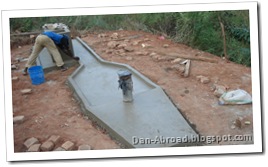 Civil Works, the concrete structures surrounding a well are what is most distinctive in the appearance of any protected water source. Shallow well or borehole.
Civil Works, the concrete structures surrounding a well are what is most distinctive in the appearance of any protected water source. Shallow well or borehole.
This is a continuation of my journaling of 4 days constructing a shallow well, to view the first post click here.
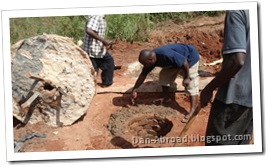 When we last left off, Foster had just finished constructing the concrete slab which protects the shallow well from surface runoff and contamination if it enters the ground water aquifer. Foster and I arrived on site in Mwambasi and he quickly bounded from the motorcycle to join the rest of the men in lifting the heavy concrete slab out of the ground, and strategically rolling it to position it over the well opening, into freshly laid cement to seal everything in place. I was entertained seeing him bound, as he usually a very soft spoken man, who enjoys deporting himself like a bwana[1], and takes himself very seriously.
When we last left off, Foster had just finished constructing the concrete slab which protects the shallow well from surface runoff and contamination if it enters the ground water aquifer. Foster and I arrived on site in Mwambasi and he quickly bounded from the motorcycle to join the rest of the men in lifting the heavy concrete slab out of the ground, and strategically rolling it to position it over the well opening, into freshly laid cement to seal everything in place. I was entertained seeing him bound, as he usually a very soft spoken man, who enjoys deporting himself like a bwana[1], and takes himself very seriously.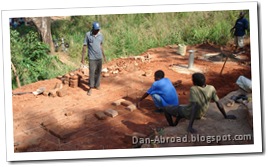
Once the slab is firmly in place, and after a short lunch break of usipa[2], beef, vegetables and nsima Foster, using string and sticks outlines the boundaries of where the concrete apron and washing station will be located. Then bricks are laid for the washing station. Surprisingly this has filled a whole day with work, and we leave a layout and few laid bricks to return and do more tomorrow.
Due to the joy of internet blogging time travel, we can continue on to the next day!
 On our return the next morning foster and I found all the brick laying completed, and the civil works beginning to take form. Bricks outline the lip of the apron surrounding the well as well as along the spillway which takes excess water away from the pump. In the picture you can also see the concrete washing sinks taking distinctive shape.
On our return the next morning foster and I found all the brick laying completed, and the civil works beginning to take form. Bricks outline the lip of the apron surrounding the well as well as along the spillway which takes excess water away from the pump. In the picture you can also see the concrete washing sinks taking distinctive shape.
 The team then gets to work meticulously covering the surfaces with concrete, and filling the base of the apron and spillway with coarse gravel and concrete. While the concrete is still wet, a wire loop is secured under where the handle will be, to allow it to be locked preventing unauthorized use.
The team then gets to work meticulously covering the surfaces with concrete, and filling the base of the apron and spillway with coarse gravel and concrete. While the concrete is still wet, a wire loop is secured under where the handle will be, to allow it to be locked preventing unauthorized use. 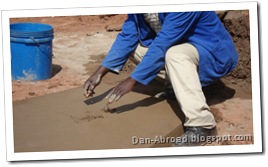 This feature on wells is viewed as controversial as it allows the committee managing the upkeep and maintenance to deny people access to the safe water if regular payments are not made to a maintenance fund.
This feature on wells is viewed as controversial as it allows the committee managing the upkeep and maintenance to deny people access to the safe water if regular payments are not made to a maintenance fund.
Once all the work of spreading and forming concrete has been completed, the civil works have finally taken their shape and need to be left to dry before the pump installation can be done. But before all this happens, the date, donor organization and name of the Village Headman are scratched into the surface of the concrete. It gives me pause to wonder when so many organizations struggle to create a sense of ownership over wells in communities the name of the community is not even placed on the well. Instead the name of the donor organization which paid for the installation with no plan for maintenance is permanently etched in concrete, ever a reminder to people they are the object of charitable programs.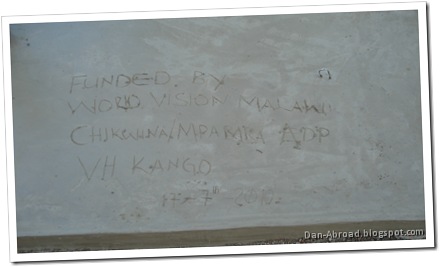
-Daniel
[1] Boss in Chitonga
[2] Small fish, the size of sardines
Daniel, it looks like you are having the best experiences of your life. I am sooooo jelous. I can't wait to see you when you come back and hear all the stories :) <3 -Darija
ReplyDelete